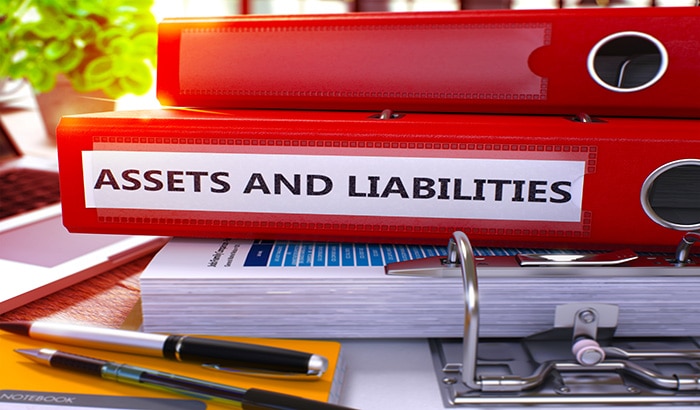Have you ever heard of assets or liabilities? You might have. But unless you’re a trained accountant, you might not know a whole lot about them.
Understanding examples of liabilities and assets and how they work is essential for every individual or business. Assets and liabilities are what make up a person’s overall net worth.
Today, we’re diving deep into these terms to help you put yourself or your business on a promising financial path. We’ll also explain how assets and liabilities can affect you legally. Keep reading to learn more about assets and liabilities.
What Are Assets and Liabilities?
Liabilities and assets are the main components of every business. These elements, paired with equity, form a picture of a company’s financial standing. This can also be applied to personal assets and liabilities, which work together to determine a person’s net worth.
Assets are everything you own. There are multiple types of assets, but the two main kinds are “current” and “fixed.” Current assets can be quickly converted into cash, while fixed assets are physical items that have financial value.
Liabilities are everything owed to other parties. This can be owed money or fees paid back over time, such as a mortgage.
In short, assets put more money in your pocket, while liabilities take it out.
An Accounting Formula for Assets and Liabilities
In accounting, businesses use a simple formula to calculate their overall equity (or net worth). To find this amount, use this accounting equation:
Total Assets – Total Liabilities = Equity/Net Worth
The goal is for the equation to result in a positive number. The higher it is, the better. If the number is negative, this is a sign of financial trouble.
What Is the Difference Between Liabilities and Assets?
Aside from their inherent meanings, here are a few more differences that distinguish liabilities and assets:
- Depreciation is an accounting method used to allocate the cost of a tangible or physical asset over its useful life.
It is a way of spreading out the cost of an asset over its expected useful life and allocating some portion of the asset cost to the profit and loss statement during a financial year over the asset’s useful life.
Assets are depreciable, while liabilities are not. - An increase in account means the balance in a particular account has increased in value. It can happen in various accounts, such as bank accounts, investment accounts, and accounting ledgers.
For example, if a company receives payment from a customer, the balance in their accounts receivable account will increase. Similarly, if an individual deposits money into their savings account, the balance in their account will increase.
An increase in accounts can signify positive financial activity. An increase in assets would be debited; however, an increase in liabilities would be credited. - A decrease in accounts means the balance in a particular account has decreased in value. This can happen in various accounts, such as bank accounts, investment accounts, and accounting ledgers.
For instance, if a company pays a vendor, the balance in its accounts payable account will decrease. Similarly, if an individual withdraws money from their checking account, the balance in their account will decrease.
A decrease in accounts can signify negative financial activity and may be a concern for an individual or organization’s financial health. However, sometimes a decrease in accounts can be a planned and necessary process, such as paying off a loan or making an investment.
A decrease in assets would be credited; however, a decrease in liabilities would be debited. - There are many types of assets, but only two types of liabilities. Current liabilities are financial obligations due within one year or a normal operating cycle. Examples of current liabilities include sales taxes, accounts payable, wages, and short-term loans.
Long-term liabilities are financial obligations due more than one year in the future. Examples of long-term liabilities include long-term loans, bonds, and leases. Both current and long-term liabilities are listed separately on a company’s balance sheet and are essential to consider when evaluating a company’s financial health. - Cash flow measures the amount of cash that flows in and out of a business over a particular period. Positive cash flow occurs when a business generates more cash inflows than outflows, while negative cash flow is the opposite.
Cash flow is an important business metric because it reflects the company’s ability to meet its financial obligations, such as paying employees, suppliers, and lenders. Cash flow can be affected by various factors, such as changes in sales, expenses, and investments.
Business owners can analyze their cash flow to identify areas to reduce expenses or increase revenue. Investors and lenders may evaluate a company’s cash flow to determine its financial strength and potential for growth. - Assets are placed first on a balance sheet, and liabilities are placed after the total assets.
Types of Assets and Liabilities
Hearing “assets” and “liabilities” might seem like confusing legalese. So, here are a few common examples of liabilities and assets to help you understand them further.
Assets:
- Cash
- Investments
- Equipment and furniture
- Computer hardware and software
- Fixtures
- Vehicles
- Buildings
- Lease agreements
- Property or land
- Boats
- Inventory
- Trademarks, patents, franchises, or any other intellectual property
Liabilities:
- Accounts payable
- Credit card debt
- Personal debt
- Mortgages
- Home equity loans
- Automobile loans
- Taxes
- Sales and income tax
- Insurance and benefits payable
- Unearned revenue
- Lawsuits payable
- Student loans
As you can see, liabilities and assets are part of anyone’s financial situation, whether you’re an individual or a business, no matter how old you are or how long you’ve had your business.
How Assets and Liabilities Can Legally Affect You
Your assets and liabilities can affect you in several ways in the legal system. One significant scenario where they come into play is in lawsuits. If you are sued for damages resulting from an accident or other incident, your liabilities will be evaluated to determine your ability to pay the damages.
If your liabilities exceed your assets, you may be forced to declare bankruptcy, which could result in the liquidation of your assets to pay off your debts.
Another scenario where assets and liabilities play a significant role is in business operations. If you own a business, your assets and liabilities will be evaluated when negotiating contracts, securing financing, and making other significant business decisions. Your liabilities could affect your ability to obtain financing, while your assets could be used as collateral to secure loans.
In estate planning, assets and liabilities also play a crucial role. When creating a will, you will need to consider your assets and liabilities to determine how your estate will be distributed after your death. If you have significant debts, your assets may need to be liquidated to pay off those debts before they can be distributed to your beneficiaries.
In all of these scenarios, an experienced attorney can help you navigate the legal system and protect your financial interests. By evaluating your assets and liabilities and providing guidance on how to manage them, an attorney can help ensure that you are making informed decisions that align with your goals and priorities while minimizing legal risks.
Flickinger • Boulton • Robson • Weeks Can Help
Here at Flickinger • Boulton • Robson • Weeks, we handle various liability cases and are ready to give you the help you need.
We would love to discuss the details of your case with you and determine the best course of action. With over 150 years of combined experience, we have the skills and expertise you need. Schedule your free consultation today!



